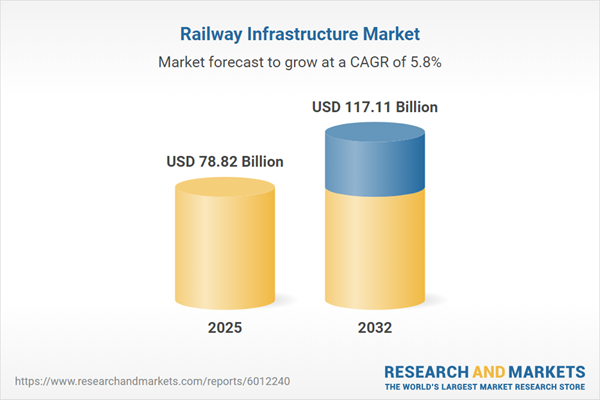Speak directly to the analyst to clarify any post sales queries you may have.
The railway infrastructure market is undergoing rapid transformation as operators, suppliers, and governments worldwide act to modernize assets, integrate advanced technologies, and meet sustainability mandates.
Market Snapshot: Railway Infrastructure Market Size and Growth
The global railway infrastructure market grew from USD 74.38 billion in 2024 to USD 78.82 billion in 2025 and is projected to reach USD 117.11 billion by 2032, reflecting a CAGR of 5.83%. This robust expansion is fueled by a global push for efficient, sustainable mobility solutions and the upgrading of both freight and passenger rail systems.
Scope & Segmentation of the Railway Infrastructure Market
This report delivers detailed analysis across all core segments and technologies within the railway infrastructure sector, with regional coverage spanning the Americas, EMEA, and Asia-Pacific.
- Track Infrastructure: Ballasted track (concrete sleeper, timber sleeper), slab track (direct fastening, embedded fastener)
- Signaling and Control: Communication-based train control (CBTC), European train control system (ETCS) – Level 1, Level 2, Level 3, positive train control (PTC)
- Electrification Equipment: Overhead catenary (compound catenary, single catenary), power substation, third rail
- Station and Yard Infrastructure: Passenger information systems, platforms (island, side), security systems
- Tunnel and Bridge Infrastructure: Bridge types (concrete, steel), tunnel methodologies (bored tunnel, cut and cover tunnel)
- Maintenance and Testing Equipment: Grinding machines, track inspection vehicles, ultrasound flaw detectors
- Geographic Coverage: North America (United States, Canada, Mexico), Latin America (Brazil, Argentina, Chile, Colombia, Peru), Europe (United Kingdom, Germany, France, Russia, Italy, Spain, Netherlands, Sweden, Poland, Switzerland), Middle East (UAE, Saudi Arabia, Qatar, Turkey, Israel), Africa (South Africa, Nigeria, Egypt, Kenya), Asia-Pacific (China, India, Japan, Australia, South Korea, Indonesia, Thailand, Malaysia, Singapore, Taiwan)
- Key Companies Profiled: Siemens Mobility GmbH, Thales SA, Alstom SA, Hitachi Rail Ltd, Wabtec Corporation, Mitsubishi Electric Corporation, ABB Ltd, Schneider Electric SE, Stadler Rail AG, Kawasaki Heavy Industries, Ltd
Key Takeaways: Strategic Insights Shaping the Railway Infrastructure Market
- Major investments in digital signaling and predictive maintenance solutions are transforming operational efficiency and reliability across networks.
- Railway infrastructure remains central to achieving carbon reduction goals, with electrification and high-capacity corridors prioritized in both mature and emerging economies.
- Project delivery models are evolving, featuring increased cross-border collaboration and a shift to modular, interoperable system architectures.
- Suppliers are responding to changing procurement strategies by expanding local manufacturing, enhancing aftersales support, and forming regional partnerships.
- Infrastructure development is closely linked with regulatory frameworks, incentivizing resilience and compliance with new safety and cybersecurity standards.
- Segment-specific advancements—such as composite sleepers or automated inspection platforms—enable asset longevity and lower life-cycle costs, supporting ambitious expansion plans.
Tariff Impact: Navigating Shifting Cost Structures
The implementation of United States tariffs in 2025 significantly influenced the railway infrastructure sector, particularly regarding supply chain adjustments and cost management. Domestic sourcing of steel and track components increased, while international projects faced heightened budget pressures due to import costs. Operators shifted procurement strategies, emphasizing value engineering, localized supplier engagement, and revised project timelines to maintain competitiveness and align with tariff-driven realities.
Methodology & Data Sources
This report is based on a blended methodology, integrating primary interviews with industry stakeholders alongside in-depth secondary research from regulatory updates, investment plans, and patent reviews. Quantitative data from global databases is verified through expert validation workshops, ensuring comprehensive and reliable market insights grounded in real-world trends.
Why This Report Matters for Railway Infrastructure Stakeholders
- Enables senior leaders to benchmark against the latest technological and policy-driven market shifts, supporting informed strategic decisions.
- Offers granular segmentation and region-specific analysis, helping asset managers and planners tailor infrastructure investments to evolving operational needs.
- Facilitates risk management by clarifying the impact of regulatory and trade developments on cost structures, supply chain resilience, and competitive positioning.
Conclusion: Strategic Direction for Decision-Makers
Leaders in the railway infrastructure market are encouraged to integrate digitization, diversify sourcing, and foster collaborative approaches. The insights provided herein support robust, future-ready strategic roadmaps.
Additional Product Information:
- Purchase of this report includes 1 year online access with quarterly updates.
- This report can be updated on request. Please contact our Customer Experience team using the Ask a Question widget on our website.
Table of Contents
3. Executive Summary
4. Market Overview
7. Cumulative Impact of Artificial Intelligence 2025
Companies Mentioned
The companies profiled in this Railway Infrastructure market report include:- Siemens Mobility GmbH
- Thales SA
- Alstom SA
- Hitachi Rail Ltd
- Wabtec Corporation
- Mitsubishi Electric Corporation
- ABB Ltd
- Schneider Electric SE
- Stadler Rail AG
- Kawasaki Heavy Industries, Ltd
Table Information
| Report Attribute | Details |
|---|---|
| No. of Pages | 184 |
| Published | October 2025 |
| Forecast Period | 2025 - 2032 |
| Estimated Market Value ( USD | $ 78.82 Billion |
| Forecasted Market Value ( USD | $ 117.11 Billion |
| Compound Annual Growth Rate | 5.8% |
| Regions Covered | Global |
| No. of Companies Mentioned | 11 |









